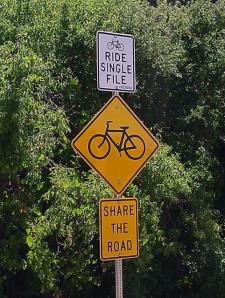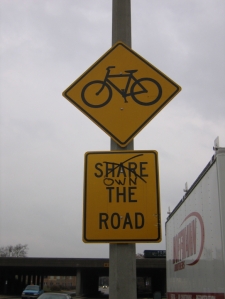Bicycle drivers “own” the road to the same extent as motorists. The driver in front is supposed to have the right-of-way and lane control whether the driver is on a bicycle or another vehicle. Photo courtesy of Karen Karabell, St. Louis.
According to the Manual on Uniform Traffic Control Devices (MUTCD) the
SHARE THE ROAD plaque is supposed to warn motorists that bicyclists are traveling along the highway. So why doesn’t it say that or something similar? Why the ambiguous SHARE THE ROAD message?
The W11-1 bicycle icon warning sign as a stand alone sign is sufficient to alert motorists to downstream bicyclists. Adding the W16-1 SHARE THE ROAD plaque results in a message that can be used and mis-interpreted the opposite of its officially intended meaning. If a supplemental plaque is to be used, there are better options than SHARE THE ROAD to warn motorists of bicycle users ahead.

The authorities in California show their hand with this installation with a regulatory sign instructing bicyclists to RIDE SINGLE FILE. Photo courtesy of Lee V. Milon and Davis Bike Club.
The SHARE THE ROAD plaque is sometimes mis-interpreted by both motorists and bicyclists to mean that bicycle users are to SHARE THE LANE by riding far right. The plaque implies the falsehood that motorists control the lane, and can choose to share some of it with bicycle users.
The SHARE THE ROAD plaque is typically misplaced on narrow roads whose lanes are not amenable for sharing side-by-side. It does not fulfill 3 of the 5 requirements of a traffic control device as described in the MUTCD.
In contrast, the new R4-11 BICYCLES MAY USE FULL LANE regulatory sign is unambiguous. It is the evolution, and supersedes the SHARE THE ROAD warning sign as the preferable message to motorists and bicyclists. A CHANGE LANES TO PASS supplemental plaque would provide added direction.
The Share The Road Sign paper HERE discusses this combination sign, and provides a rationale for dispensing with the “SHARE THE ROAD” placard.

February 9, 2012 at 12:15 pm
My thoughts are aptly expressed in “Share the Road, STINKS”
http://www.ohiobikelawyer.com/uncategorized/2010/09/share-the-road-stinks/
You hit it on the head in that the signs are misinterpreted. However, around here they are used on the big, wide bike thoroughfares and not, generally, on those tight curvy roads where bikes are permitted but not really tolerated by motorists… they should be called “Bikes Might Be In The Way” signs for motorists…
February 9, 2012 at 1:18 pm
I always thought the sign should say “Expect Bicycle Traffic” as a reminder to be vigilant (which they should be at all times anyway). Of course, to follow up on Steve’s comment, that might be interpreted as “Expect Bicycles To Be In The Way”.
February 9, 2012 at 2:27 pm
I like Change Lanes to Pass – the current sign is good on intent but poor on specifics, in my view. In NJ there’s a law that applies when encountering horses on the roadway, which requires slowing to 25mph and following the horseperson’s hand signals for when to pass. I like that approach better than the current ambiguity, too, and believe it could be adopted/adapted for bicyclists.
February 10, 2012 at 3:37 am
“Narrow Lane”
February 10, 2012 at 5:27 pm
All good thoughts. Thanks.
July 19, 2012 at 10:34 am
STR signs are wasted paint, no one has to share anything if they don’t want to, not sharing is not actionable
Use caution, Bicycles on the Road (or similar), not using “caution” IS actionable…………….its called negligence
July 20, 2012 at 10:30 am
Please note that the “Ride Single File” sign in the photo above was apparently installed by California’s Solano County Public Works Dept. It’s a local anomaly that we hope to get removed soon. It’s not a sign for statewide use.
July 20, 2012 at 7:57 pm
Thanks David. Irrespective of the installing agency, the “Ride Single File” paired with the STR sign exemplifies the misinterpretation and misuse of the STR sign.
October 1, 2012 at 12:54 pm
I am going to mount a milk crate on top of my rear bike rack. I am going to bolt a reflective R4-11 “BIKE MAY USE FULL LANE” sign to the milk crate. The standard sign is 30”, so I will need to special order a smaller size. It is going to be glorious!
October 1, 2012 at 3:02 pm
That’ll be fabulous.
Regards, Wayne
April 9, 2014 at 12:00 pm
Coming to this post late.
I like signs with just the bike symbol or those with “CAUTION BICYCLES” in heavy traffic or otherwise areas with higher probabilities of adverse incidents.
One feature of a poor sign is that as reasonable person could infer that it applies to only that circumstance or stretch of road when in fact it is intended as a reminder of something that more generally applies. For this reason “BICYCLES MAY USE FULL LANE” is not that useful in my mind: it could be reasonably inferred by a motorist that if that sign isn’t present, bicycles may not use the full lane; just like a motorist who thinks that if a STR isn’t present, bicycles are subservient. This is not a problem when it comes to just reminding motorists that bikes are a fact (with a simple bike symbol).
“CHANGE LANE TO PASS”: so does that apply to bikes, which are also vehicles? Probably not, so I don’t like that solution either.
April 9, 2014 at 3:09 pm
Hi Alex,
Yes, some others share similar concerns that you note. But using that same logic, should motorists not think about bicyclists on roads that don’t have a simple bicycle icon sign?
Regards,
Wayne
April 11, 2017 at 4:07 pm
[…] 1. Critique of Share the Road (2012) https://bicyclingmatters.wordpress.com/infrastructure/critique-of-the-share-the-road-sign/ […]
December 20, 2021 at 3:41 pm
The rules y’all come up with smh… no bicycle rider should not share the same rights as a motorist… when a motorist has to take a permit test and also has to take a drivers test. Then spend thousands of dollars of on a car and pay car insurance every month. Just for a person to only have to purchase a bike. So if a biker knock off my mirror or scratch my car due to their negligence. How does mortorist handle this, when they don’t have license plates? Because the biker can sue the motorist insurance due to the motorist negligence… Bottomline, before giving bikers the same rights as motorists on the road. Bicyclist should have to obtain a permit and insurance as well. Also the speed limit on most city streets are 25 mph. So if they can’t keep up then why tide in the street.
September 26, 2022 at 2:46 am
The dashed bike lane looks similar to the standard bike lane, but its lines are broken or dotted. This means that the space is not exclusive to bicycles and is shared with motorized vehicles as well.